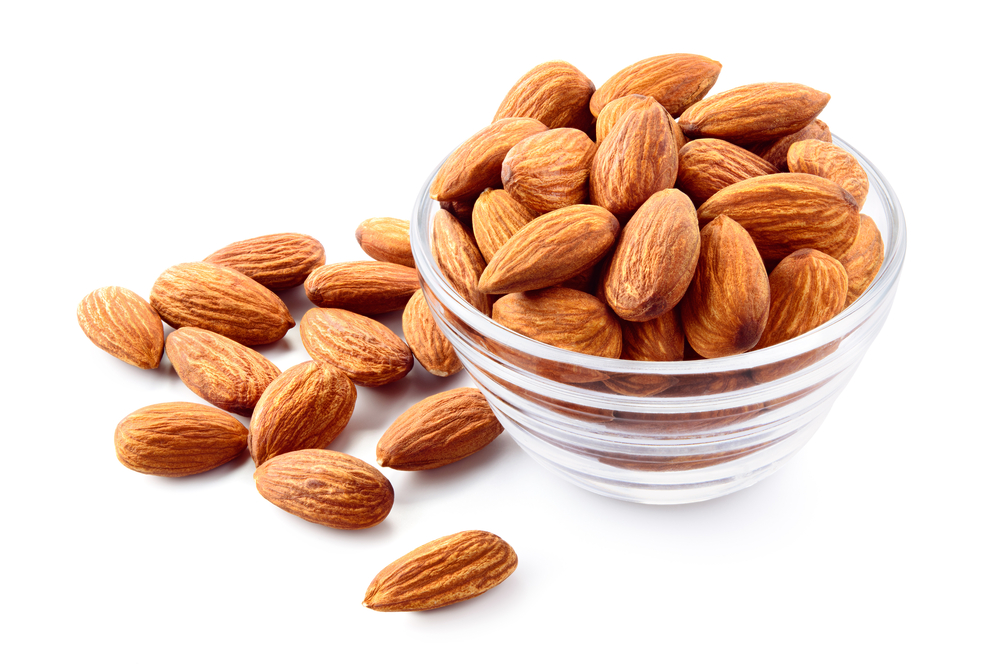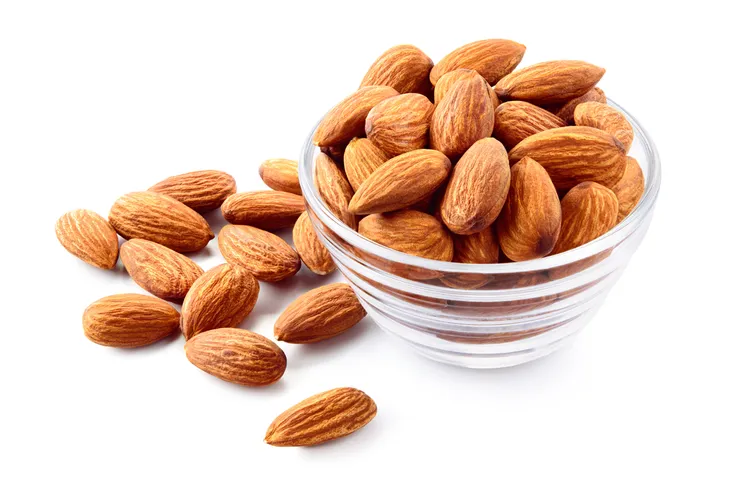I don’t have to tell you guys that I’m a bit of a health nut—so it’s no surprise that I’m alllll about almonds and almond products (i.e., almond milk, almond butter, and almond flour) for their amazing and numerous health benefits. Fitting healthy almond sources into your daily diet is easier than you think, here’s how I ensure I’m getting the NUTritional benefits of almonds every week…
Snack on Raw Almonds
Almonds can be used in many culinary forms, but let’s start off with the simplest and perhaps the most satisfying—raw almonds as a filling mid-morning or mid-afternoon snack.
Almonds are jam-packed with nutrients, such as vitamin B2, vitamin E, calcium, iron, phosphorus and magnesium. And don’t forget the fiber, heart healthy fats, antioxidants, and folate in each crunchy bite.
Boost Energy with Almonds
In fact, almonds are great for a midday energy boost or pre-workout snack. So much so that Harvard Medical School credits almonds for their cholesterol benefits—including reducing cardiovascular events (i.e., heart attack) by regularly munching on raw nuts.
This is due to the high monounsaturated fat (and low saturated fat content) in almonds, which promotes healthy cholesterol levels and cardiovascular health. Consider snacking on a handful of almonds instead of a handful of potato chips to ward off an afternoon energy slump. Trust me, you’ll feel satisfied for much longer.
Garnish with Almonds
As far as garnishes go, raw almonds are high in protein, rich in phosphorus, potassium, and zinc, and also a source of calcium and heart healthy fats. It’s fairly easy to get the recommended 3 servings per day of almonds or almond products to reach your daily calcium goals of 1,200 milligrams for women and 1,000-milligrams for men.
Start in the morning by sprinkling slivered almonds over oats or breakfast cereal. Prepare a mid-morning snack of Greek yogurt with almonds on top. Or smear a bit of raw almond butter on whole grain toast or pita bread. You can also replace several unhealthy condiments and garnishes with the healthy crunch of almonds. Try substituting croutons on salad for a handful of almonds. And add crushed almonds rather than sugary sprinkles to frozen yogurt desserts.
Almonds Pre-Workout
I always reach for almonds as my pre-workout snack because these nuts are a rich source of healthy energy as well as calcium, magnesium, and phosphorus—3 essential nutrients that keep bones strong and prevent injuries and fractures.
If your body is deficient in calcium, magnesium, or phosphorus your bones can really take a beating. According to the Centers for Disease Control and Prevention (CDC), roughly 25-million American men and women over the age of 25-years suffer from degenerative bone diseases (i.e., osteoarthritis or OA). Degenerative bone diseases like OA and osteoporosis are often due to magnesium deficiency.
Almond Milk vs. Cow’s Milk
When I reach for a carton to blend with my breakfast smoothie or even to whiten my coffee, I choose the nutty fragrant flavor of almond milk for its light, velvety texture. These days almond milk is fairly easy to find in the grocery store (it’s usually right beside the cow’s milk and other milk alternatives).
Keep in mind that almond milk, per cup, is often lower in both fat and calories than cow’s milk. Take for example one cup of vanilla-flavored unsweetened almond milk at 35-calories and 3-grams of fat versus one cup of 2-percent cow’s milk at roughly 120 calories and 5-grams of fat. This is largely because almond milk is not an animal product, making it low in both saturated fat and cholesterol as well as a suitable milk substitute for vegetarians, vegans, those on a heart-healthy diet.
Versatility of Almond Milk
Even though a carton of almond milk can be slightly pricier than cow’s milk or even soy milk, for me, the versatility of almond milk largely outweighs the marginally higher cost.
For instance, almond milk is multipurpose. I pour it over cereal, use it in coffee, blend it into smoothies, and use it to flavor soups and curries. Plus, almond milk is available in several flavors—like vanilla, chocolate, original, and unsweetened versions—so you’ll never get bored of the same old flavor.
Overall, although almonds and almond products may be a good alternative, the environmental factor should be considered. Almonds require a lot of resources such as water. therefore, it is best to have a variety of nuts instead of using an excess amount of almonds or almond products.









